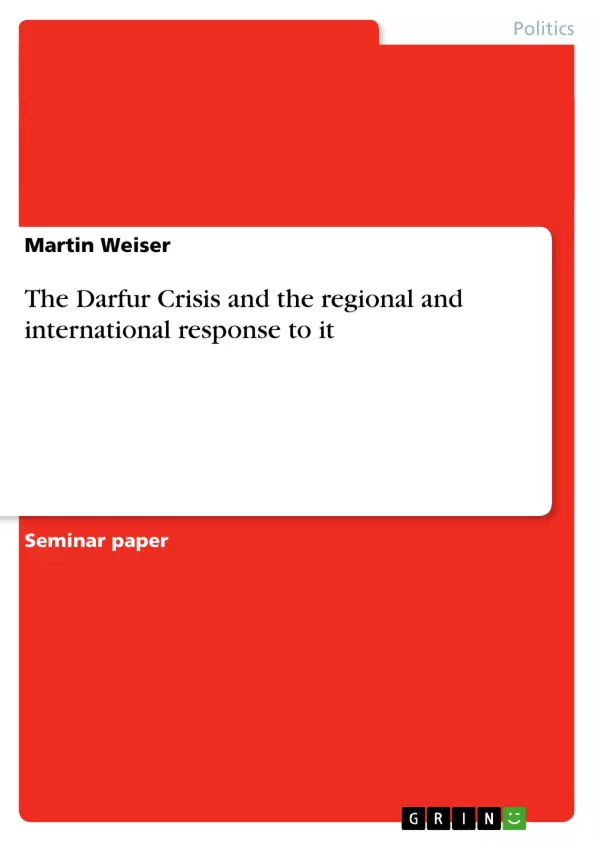The conflict in Darfur has been repeatedly described as one of the worst humanitarian crises the world is facing nowadays. With hundreds of thousands killed and millions more displaced it is still ongoing. In this paper I would like to look at the conflict situation from two perspectives.
Firstly, in the first segment of my work, I will try to describe the conflict and its roots as well as explain its origins. For a better understanding I divided this chapter into several sub-chapters dealing with: the background to Darfur; historical roots of the conflict and most importantly with the current conflict focusing on patterns of violence, the actual situation, the IDP camps and sexual violence.
In the second half of my paper I tried to look at the conflict from a different perspective, from a perspective of international actors, above all the Western democratic countries in the sub-chapter about the question of genocide and the UN and the AU in the two following sub-chapters.
For this paper I used a number of sources, both books and journals or newspaper articles. However, Prunier’s book “Darfur: The Ambiguous Genocide” proved to be the most useful one, since it still is one of the few books dealing precisely with this subject that is available.
Inhaltsverzeichnis (Table of Contents)
- Introduction
- Darfur Crisis and its Origins
- Essential Background
- Historical Roots
- Darfur - a Region for Proxy Wars
- Current Conflict
- Patterns of Violence
- Actual Situation
- The IDP Camps
- Sexual Violence
- Conflict Explained
- International Response
- The Genocide Discussion
- International Players
- The AU
- The UN
- Other Actors
- Conclusion
Zielsetzung und Themenschwerpunkte (Objectives and Key Themes)
This paper examines the Darfur crisis from two perspectives: the origins and dynamics of the conflict, and the international response. The paper aims to provide a comprehensive understanding of the crisis, including its historical roots, the patterns of violence, and the current situation. The key themes explored in the paper include:- The historical and political context of the Darfur crisis
- The role of external actors in the conflict
- The impact of the conflict on the civilian population
- The challenges of international intervention in Darfur
- The ongoing humanitarian crisis in Darfur
Zusammenfassung der Kapitel (Chapter Summaries)
The first chapter provides a detailed analysis of the Darfur crisis, focusing on its origins and the key factors contributing to its escalation. It delves into the historical context, including the region's political and economic marginalization, the rise of ethnic tensions, and the impact of environmental degradation. The chapter also examines the patterns of violence, the actual situation on the ground, the plight of internally displaced persons (IDPs), and the prevalence of sexual violence. The second chapter shifts focus to the international response to the Darfur crisis. It explores the debate surrounding the use of the term "genocide" to describe the atrocities committed in the region, and analyzes the roles played by various international actors, including the African Union (AU), the United Nations (UN), and other organizations.Schlüsselwörter (Keywords)
The Darfur crisis is a complex and multifaceted issue, with a wide range of relevant keywords and focus topics. These include: Sudan, conflict, genocide, humanitarian crisis, international response, African Union, United Nations, displacement, violence, ethnic tensions, environmental degradation, and proxy wars.- Citar trabajo
- Martin Weiser (Autor), 2007, The Darfur Crisis and the regional and international response to it, Múnich, GRIN Verlag, https://www.grin.com/document/90883



